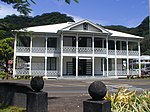The High Court of American Samoa is a Samoan court and the highest court below the United States Supreme Court in American Samoa. The Court is located in the capital of Fagatogo. It consists of one chief justice and one associate justice, appointed by the United States Secretary of the Interior, holding office during "good behavior" and removable for cause.[2] As American Samoa has no local federal district court or territorial court, the High Court has also been granted the powers of a federal district court in certain matters while other federal matters are handled by the United States District Court for the District of Columbia and the United States District Court for the District of Hawaii.[3]
| High Court of American Samoa | |
|---|---|
 The High Court of American Samoa courthouse | |
 | |
| Established | 1921 (103 years ago) |
| Jurisdiction | American Samoa |
| Location | Fagatogo, American Samoa |
| Composition method | Appointed by the United States Secretary of the Interior |
| Authorized by | Constitution of American Samoa |
| Appeals to | United States Secretary of the Interior (no appeals in practice)[1] |
| Number of positions | 2 |
| Chief Justice | |
| Currently | Michael Kruse |
| Since | 1988 |
The High Court of American Samoa also has several Samoan associate judges who sit with the two justices. Normally, two associate judges will sit with the chief justice and associate justice on every case.
The Secretary of the Interior retains ultimate authority over the courts.[4]
The colonial-style Maugaolii High Court served as the U.S. Navy headquarters during World War II.[5]
Organization
editThe High Court consists of four divisions:[2]
- the trial division;
- the probate division;
- the land and titles division; and
- the appellate division.
The trial division, which consists of the Chief Justice, the Associate Justice, and associate judges, is a court of general jurisdiction, empowered to hear, among other things, felony cases and civil cases in which the amount in controversy exceeds $5,000.
Justices
editThe past and present justices of the court:[6]
See also
editReferences
edit- ^ https://digital.law.washington.edu/dspace-law/bitstream/handle/1773.1/552/17PacRimLPolyJ325.pdf?sequence=1, 351.
- ^ a b Tagupa 1983, p. 23.
- ^ "American Samoa: Issues Associated with Some Federal Court Options". Government Accountability Office. September 18, 2008.
- ^ Leibowitz, Arnold H (1989). Defining Status: A Comprehensive Analysis of United States Territorial Relations. p. 420. ISBN 978-0-7923-0069-4.
His legal position would not only permit him to investigate and overturn decisions of the judiciary in American Samoa, but the decisions of the Executive and Legislative branches as well. … The very fact that his office exists as an ombudsman, to put it kindly, or as a benevolent dictator — to put it less generously — depreciates all Samoan government institutions and makes the Samoan Constitution adopted in 1960 a giant deceit.
- ^ Schermeister, Phil (2016). National Geographic Guide to National Parks of the United States. National Geographic Books. ISBN 9781426216510.
- ^ "Past High Court Justices". American Samoa Bar Association. March 19, 2012. Retrieved May 16, 2022.
- Tagupa, William E. H (September 1983). "Judicial Intervention in Matai Title Succession Disputes in American Samoa". Oceania. 54 (1): 23–31. doi:10.1002/j.1834-4461.1983.tb02015.x. JSTOR 40330715.
External links
edit- American Samoa Legal Database
- "American Samoa", Caselaw Access Project, Harvard Law School, OCLC 1078785565,
Court decisions freely available to the public online, in a consistent format, digitized from the collection of the Harvard Law Library